How to grow an Apeldoorn tulip in the garden?
The tulip variety Apeldoorn is known to many, even to those who do not know its name. It was created by the breeder Lefeber in 1951. He served as the basis for the creation of other varieties, while he himself is still in demand.
Content:
Description of the variety
Tulip Apeldoorn belongs to Darwin's hybrids. The flowering dates are early. Usually this is the beginning of May, but the warming of recent years has slightly pushed the flowering dates to earlier dates. The plant reaches a height of 45 to 60 cm. The stem is strong. The flower is goblet, the petals have a traditional shape.
The diameter of the flower in the middle of flowering reaches 6 cm, and in the open state 10 cm.
Same glass height. But it reaches such dimensions gradually, dissolving, and increases in volume. Color - pure fiery red, black closer to the bottom. The flower pistil is light, the anthers are black. They are attached with dark threads.
Tulip varieties Apeldoorn differ in petal colors and flowering times:
- The petals of the Apeldoorn Elite variety, created in 1968, are orange-yellow, with a wide yellow border running along the edge. The diameter of the flower in the open state reaches 12 cm.
- The petals of the Golden Apeldoorn tulip are bright yellow. Medium flowering variety. It can grow not only in sunny areas and in partial shade, but also in the shade.
Reproduction
Tulip Apeldoorn reproduces well with daughter bulbs and seeds. In place of the flower, a box with seeds is formed. If you plan to propagate the flower with bulbs, the stems are cut at a height of about 10 cm above the ground. In this case, he will not pull forces from the bulb, and it will form large daughter ones.
After the leaves tulip dry up - dig up the bulbs.
Dry for a couple of days under a canopy. Then the daughter bulbs, soil, roots are separated. Sorted by size. Put in bags or nets, sign. For the first month, the bulbs are stored at a temperature of about 20 ° C, then it is gradually reduced to 12 ° C. Maintaining high humidity (80%) prevents the bulbs from drying out. Bulbs will not disappear even at a higher temperature. Only flowering next year in such specimens will be observed later.
Planting
Choosing a place to grow tulips, give preference to sunny, cozy areas, protected from the north wind. Possibly partial shade at certain times. To prevent the bulbs from getting wet, the groundwater should not approach the surface of the earth closer than 60 cm.
Tulips prefer sandy loam soil, light, nutritious, neutral acidity or alkaline. They do not like acidic soils. You can deacidify by adding dolomite flour, slaked lime at the rate of 50 g per square meter. If the soil is heavy clay, add 2 buckets of river sand per square meter of area.
They bring in rotted humus and completely decomposed compost... If not rotted areas remain in it, they can serve as a source of fungal diseases. Fresh pus, getting to the bulb, burns its roots.
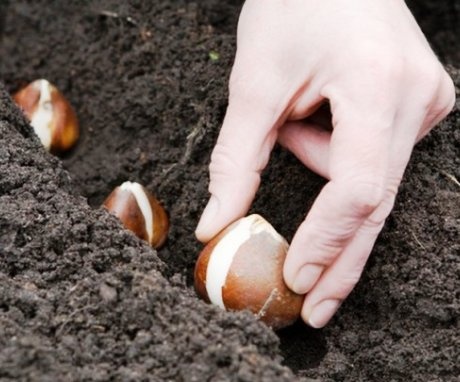
Development and flowering largely depends on the predecessors that grew before this on the site. Tulips are not planted after other bulbs and nightshades (potatoes, tomato, pepper, eggplant). This is due to the fact that they have common viral diseases.Tulip bulbs Apeldoorn respond well to the introduction of wood ash just before planting. The layer thickness is about 1 cm.
The bulbs are planted in the ground in September or October, along with winter garlic. Early varieties of Apeldoorn tulip are planted a week earlier than average (Gold). The exact planting time can be determined by the temperature of the soil. For large bulbs at a depth of 10 cm, it should drop to 10 ° C, small ones are planted at a soil temperature of 15 ° C. If planted at a higher temperature, the flower will germinate faster, throw out the arrow and die from frost.
Before planting, the bulbs are examined, the exfoliated skin is removed, the damaged and stained ones are selected and discarded.
They are being destroyed. I disinfect high-quality bulbs fungicides... You can immerse it in a 0.2% solution of foundationol for an hour. Then dried in the fresh air. If a solution of potassium permanganate is used for disinfection, the bulbs are planted without drying.
Features of planting tulip bulbs:
- Planting depth depends on the size of the bulb and is three times its height. If you plant them very deeply, the number of babies will decrease. If it is shallow, the flowers will fade faster. And the bulbs degenerate in a couple of years. Tulips are usually planted in rows or groups. They dig grooves in the area or prepare holes for each bulb separately (for large specimens). The distance between the bulbs is at least 20 cm. If planted very tightly to each other, it will be more difficult to dig them out in the summer.
- The bulbs are planted according to size. The largest ones are in the foreground. The distance between them is left at least 20 cm. Smaller bulbs are planted in the background, leaving at least 10 cm between them. If there are even less specimens left, they are planted further away. They will not bloom next year, but they may well produce beautiful flowers in a year.
- For several years in a row, about 5 years, they can be grown in one place, digging and planting every year. But if for some reason it is not possible to dig them out, they may well live for several years without a transplant. Of course, the bushes will become thickened, and the flowering is moderate, but subsequent transplantation will help preserve the variety and restore flowering.
- Tulips can be planted in the spring, but in order for them to bloom, they must be kept at a temperature of about 7 ° C in winter. You can also dig up a tulip bush that is left overwintering in the ground in the spring and plant them separately. Flowering will be weak, some specimens may not bloom at all.
Tulip Apeldoorn is not afraid of spring frosts. Its leaves and buds can withstand temperatures as low as -4 ° C. But the planted bulbs still need to be mulched with humus or compost. It will protect against winter frosts and sudden temperature changes at this time.
Tulip care
In the spring, the aisles are loosened, embedding humus into the soil. It contains nitrogen, therefore it will promote enhanced plant growth. Plantings are examined, plants affected by diseases are removed. Dig up and non-sprouted bulbs, throw them away.
How to care for tulips:
- The amount of watering depends on the moisture content of the soil. It should not be overdried, but strong moisture can lead to rotting of the bulbs.
- After the Apeldoorn tulip has a third leaf, complex mineral fertilizers... The flowers of this variety are large, but they can be made even larger. For this, the plants are fed with potash and phosphorus fertilizers. Top dressing with complex fertilizers is repeated during the period of the opening bud. They are brought in after watering or rain, after application they are watered again. In no case should you use chlorine-containing fertilizers.
Tulip Apeldoorn is resistant to one of the main viral diseases - variegation. But the lack of certain trace elements can lead to a change in the color and shape of the leaves.
Lack of zinc, boron and molybdenum can cause chlorosis. White spots will appear on the leaves.The stems are thinning. The leaves turn white even with a lack of sulfur. The yellow color of the leaves indicates a lack of iron in the soil. Drying of the tips of the leaves occurs when the amount of magnesium is insufficient. These bulbs are not used for forcing.
Use in the garden
You can please loved ones with flowers of this tulip variety in February or March. They are suitable for forcing. Apeldoorn tulips are prized for their beautiful early flowers in open field. It is advisable to grow them in groups of at least 5-8 bushes. You can create any compositions by combining with tulips of other early varieties, forget-me-nots, daffodils, dicenter.
After flowering, tulip leaves cannot be cut off. They will dry out for some time and spoil the appearance of the flower bed. To remedy this, late flowering plants are planted in front.
Tulips can be grown in special containers or baskets that are dug out of the ground after they have faded.
They are transferred to a secluded place where the plants will ripen. Due to the fact that tulips of this variety do not fall off for a long time, they are used for cutting.
More information can be found in the video:



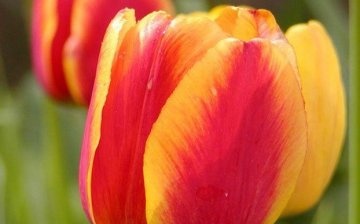
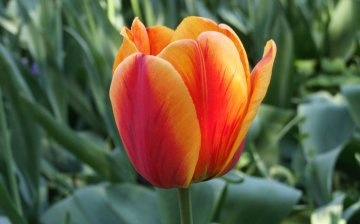


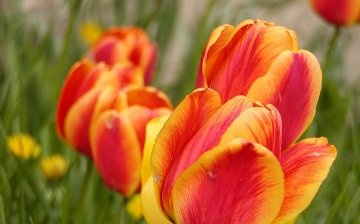








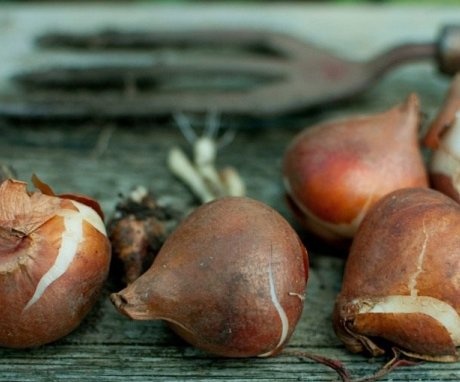
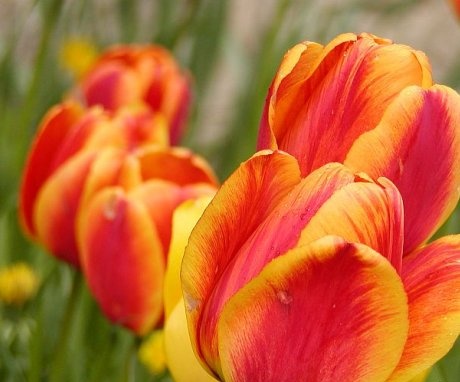
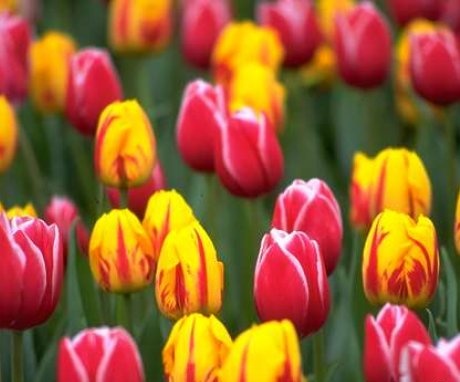
We planted the Apeldoorn tulip at our dacha. Quite a tall stem, but whimsical to watering, if the ground is dry, the bud opens up strongly. The largest flower was 10 cm in diameter. The color is pure red, planted in early October.
Wow! I have this kind of tulip. It grows in the garden by itself. I don’t transplant it, I don’t dig out bulbs for the winter. During the winter they do not freeze and in the spring they delight with new flowers.
When I plant flowers, I always want the flower bed to look thick and rich, but at the same moment I come across some peculiarities of planting. How to plant tulip flowers to make the flower bed look thick?